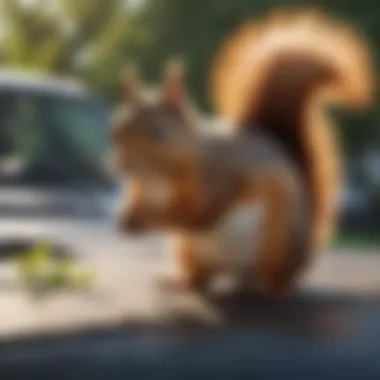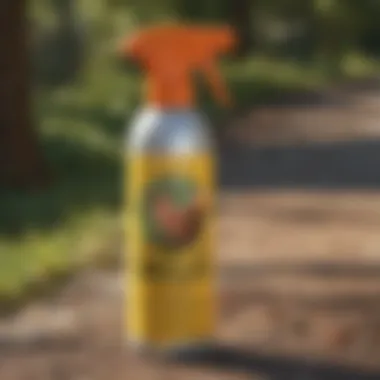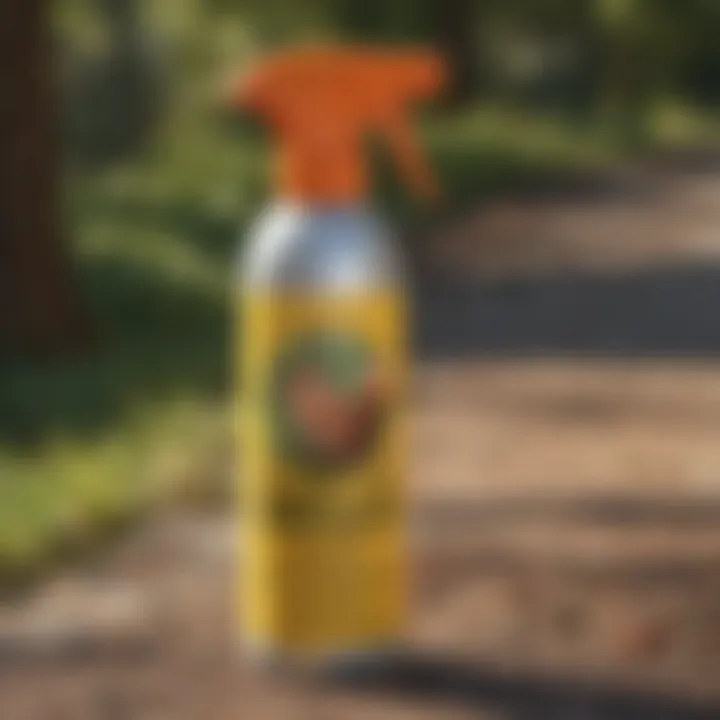Understanding Squirrel Car Repellent: An In-Depth Exploration


Intro
Squirrel car repellent has become a crucial topic for many homeowners who want to protect their vehicles. These small creatures can cause significant damage to automotive components, particularly wiring, which may lead to costly repairs. Understanding how the repellent works and its effectiveness is essential for anyone facing squirrel issues in their vicinity.
In this article, we will delve into the essential concepts surrounding squirrel damage, explore prevention methods, and present various control strategies. Through this exploration, you will gain insights into the natural behaviors of squirrels and how they interact with your car. We aim to equip housewives and homeowners with practical knowledge that helps mitigate this problem effectively.
Understanding the Pest
Identification
Squirrels are small rodents commonly found in many suburban and urban areas. They are characterized by their bushy tails, sharp claws, and adaptability to various environments. The most common species that cause issues are the Eastern Gray Squirrel and the Fox Squirrel.
To spot a squirrel, look for a creature around 16 to 20 inches long, with a tail almost as long as its body. Color varies but often ranges from gray to reddish-brown. Their large, beady eyes and long, pointed noses are distinct features as well.
Life Cycle
Understanding the life cycle of squirrels can help homeowners identify potential problems. Squirrels typically breed twice a year. The gestation period lasts around 44 days. After birth, the young remain in the nest for about eight weeks, relying on their mother for food. Squirrels become independent early, around three months old.
During spring and summer, squirrel populations can increase dramatically. This rise leads to more frequent encounters with vehicles as squirrels search for food and nesting materials.
Note: Squirrels often look for nesting sites in unusual places, including under the hoods of parked cars.
Pest Prevention Strategies
Environment Modification
One effective way to deter squirrels is by modifying the environment around where cars are parked. Make sure to remove any food sources that might attract them. This includes:
- Cleaning up fallen fruits or nuts from trees
- Keeping garbage bins sealed tightly
- Avoiding leaving pet food outside
Additionally, consider using motion-activated sprinklers or lights, which can frighten squirrels away.
Physical Barriers
Installing physical barriers can be another way to protect vehicles from squirrels. Some suggestions include:
- Using protective car covers made of thick material that squirrels cannot easily chew
- Parking in enclosed or secured garages when possible
- Applying mesh or grill covers to block entry points in engine compartments
These methods can reduce the likelihood of squirrels nesting in your vehicle.
Control Methods
Chemical Control
Chemical control involves using specially formulated repellents. Many commercial products contain ingredients that emit strong odors, unpleasant to squirrels. It is crucial to follow the instructions provided for each product to ensure safety and effectiveness. Always test a small area first to check for any adverse reactions on the vehicle's surface.
Biological Control
Biological control employs natural predator scents to deter squirrels. Some homeowners have found success using products that mimic the smell of foxes or other predators. The idea is that these scents create an environment where squirrels feel threatened, prompting them to avoid those areas.
Integrating both chemical and biological methods may yield the best results, minimizing your vulnerability to squirrel-related damage.
Preface to Squirrel Car Repellent
Understanding squirrel car repellent is crucial for those who seek to protect their vehicles from the damage that squirrels can inflict. These small creatures often cause significant harm by chewing on wires, nesting under hoods, and creating general havoc within parked cars. This exploration delves into the various aspects of squirrel car repellent, highlighting its importance in effective pest management, particularly in urban and suburban settings where human-squirrel interactions are frequent.
Defining Squirrel Car Repellent


Squirrel car repellent refers to products designed to deter squirrels from approaching vehicles and nesting within specific areas. These repellents can take various forms, including sprays, granules, and electronic devices. The active ingredients in these products may range from natural extracts to synthetic chemicals engineered to produce scents or tastes that squirrels find unpleasant. Understanding what constitutes a squirrel car repellent helps users make informed decisions when selecting a product that suits their specific needs.
The Importance of Pest Management in Vehicles
Pest management in vehicles is not just about protecting the car's interior; it is also crucial for maintaining vehicle safety and operational integrity.
- Damage Prevention: Addressing squirrel infestations can prevent costly repairs due to gnawed wires or damaged components.
- Health Concerns: Squirrels can carry diseases that may be transmitted through contact with urine or droppings.
- Long-term Solutions: Effective management reduces the likelihood of future infestations, creating a sustainable approach to vehicle care.
Using squirrel car repellent as part of a broader pest control strategy enhances a vehicle owner's peace of mind while protecting their investment.
"Ignoring the problem often leads to more serious issues and more expensive repairs."
Behavioral Patterns of Squirrels
Understanding the behavioral patterns of squirrels is essential when evaluating the risks they pose to vehicles. Their activities often lead to extensive damages, making it crucial for car owners to be informed. Knowledge about how squirrels behave, their habitats, and their potential interactions with vehicles guides the development of effective repellent strategies.
Squirrel Habitat and Activity
Squirrels thrive in various environments. They are commonly found in wooded areas as well as urban settings. These creatures build nests or dreys high in trees, often near roads where they become more visible. Their adaptability allows them to forage in gardens, parks, and even parking lots.
Squirrels are diurnal, meaning they are most active during the day. Early morning and late afternoon are peak times for their foraging activities. Understanding this cycle is vital for car owners. When a vehicle is parked in areas frequented by squirrels, the likelihood of an encounter increases. Recognizing their active hours can help in choosing safer parking spots to minimize damage.
Additionally, squirrels exhibit specific nesting behaviors that can lead them towards vehicles. Often, they seek shelter in the warmth of an engine, particularly in colder months. The engine's heat makes it an attractive spot for nesting, unfortunately, causing significant risks and even accidents.
Common Behaviors Leading to Vehicle Damage
Squirrels display several behaviors that can directly affect vehicle integrity. Their instinct to gnaw is a primary concern. Squirrels need to chew on materials to keep their teeth from growing too long. Their targets often include hoses, electrical wiring, and insulation within vehicles.
An important aspect to note is their natural curiosity. Squirrels explore their surroundings vigorously. This often leads them to investigate the components of parked cars.
Some common behaviors contributing to vehicle damage include:
- Nesting in the engine bay: This can lead to significant mechanical issues and fire hazards if they nest inside the engine compartment.
- Gnawing wires and hoses: This behavior can cripple essential vehicle functions.
- Foraging for food: Squirrels may dig or scratch at vehicles, hoping to find morsels of food, which can leave behind unsightly marks and scratches.
Understanding these behaviors equips homeowners with the knowledge needed to implement effective deterrence strategies to safeguard their vehicles.
"Awareness of squirrel behavior plays a crucial role in preventing vehicle damage. The more you know, the better you can protect your investment."
By combining insights about habitat, activity, and behaviors, car owners can make informed decisions about how to mitigate risks effectively.
Chemical vs. Non-Chemical Repellents
Understanding the differences between chemical and non-chemical repellents is critical in developing effective strategies for squirrel management. Each type of repellent has its own set of characteristics, benefits, and considerations that cater to different needs and environmental preferences. This section aims to provide clarity on these options, empowering readers to make informed decisions that align with their values and circumstances.
Overview of Chemical Repellents
Chemical repellents are products that utilize synthetic substances to deter squirrels from vehicles. These products are often designed to create an unpleasant odor or taste for these pests. Common examples include formulations based on naphthalene or mothballs. These substances can be effective in providing immediate results, but they also come with a host of concerns.
- Effectiveness: Chemical repellents typically work quickly, allowing users to see results in a short time.
- Longevity: Some chemical repellents have a longer duration of effectiveness compared to their non-chemical counterparts.
- Considerations: The use of chemical repellents raises environmental and health concerns. Residues can linger, affecting not just squirrels but also beneficial wildlife. In addition, some chemical ingredients can pose risks to humans and pets, especially if inappropriately used.
As such, anyone considering chemical options must weigh the benefits against the potential hazards and check the relevant safety guidelines regarding application and use, detailed in resources such as Britannica.
Eco-Friendly Non-Chemical Alternatives
Non-chemical repellents provide a more environmentally conscious way to manage squirrel intrusions. They utilize natural ingredients or physical barriers designed to deter squirrels without toxic chemicals. Here are some popular non-chemical methods:
- Essential Oils: Oils such as peppermint and cinnamon are known for their strong scents, which can effectively irritate a squirrel's sensitive nose. Spraying diluted mixtures of these oils around a vehicle can help keep squirrels at bay.
- Ultrasonic Devices: These devices emit sounds at frequencies that are unpleasant for squirrels but generally inaudible to humans. They offer a way to repel while being safe for the environment.
- Physical Barriers: Creating barriers using materials that squirrels find hard to cross can provide a physical deterrent. This may include using netting around the vehicle or securing parts of the engine with specially designed covers.
- Traps and Relocation: Though not a repellent in the strictest sense, setting humane traps allows one to capture squirrels and release them far from residential areas.


The benefits of non-chemical options extend beyond safety; they also align with a growing desire for sustainable practices. Non-chemical methods often have fewer side effects on surrounding wildlife and facilitate a more balanced ecosystem.
"Choosing non-chemical repellents not only helps address immediate squirrel nuisances but also contributes to long-term environmental health."
Effectiveness of Squirrel Car Repellents
The effectiveness of squirrel car repellents is a focal point in understanding how to protect vehicles from damage caused by these animals. Effective repellents are not just about driving squirrels away; they play a crucial role in keeping cars safe from the costly impacts of gnawed wiring and chewed insulation. The right repellent can save homeowners significant repair expenses and extend the lifespan of their vehicles.
When evaluating the effectiveness of squirrel repellents, there are several significant factors to consider that directly influence how well these products work in the real world.
Factors Influencing Repellent Efficiency
- Type of Ingredients Used: The effectiveness can vary greatly based on whether a repellent contains chemical or natural ingredients. Certain chemicals may deter squirrels effectively but could pose environmental risks.
- Application Frequency: How often the repellent is applied also matters. For maximum efficacy, regular reapplications based on weather conditions and product instructions are usually recommended.
- Target Environment: The placement and surrounding environment influence how well a repellent works. Areas with high wildlife activity might require stronger repellents or different strategies compared to urban settings.
- Squirrel Behavior: Understanding squirrel habits and behavioral patterns is essential. For example, if a squirrel has established a food source nearby, it may resist deterrents in favor of the known rewards.
- Product Formulation: Some products are designed to block scent trails or disrupt communication among squirrels, thereby enhancing effectiveness.
"The correct application can significantly improve the efficacy of squirrel repellents, reducing potential vehicle damage substantially."
Scientific Studies on Repelling Squirrels
Recent scientific studies have investigated the effectiveness of various squirrel repellents. Research often focuses on both short-term and long-term results, analyzing the persistence of repellent effects and any adaptation by squirrel populations. Some studies suggest potential resistance development, where squirrels become accustomed to a repellent and thus less likely to be deterred over time.
In one study, researchers applied different repellents in controlled environments to gauge their effectiveness. Results indicated significant variances in how well different products worked, emphasizing the importance of empirical testing in real-world conditions. The findings suggest that a multidimensional approach, integrating different repellents and techniques, may yield better results overall.
In summary, while the effectiveness of squirrel car repellents can vary, understanding these elements helps homeowners choose and apply the right products, significantly reducing the risk of vehicle damage.
Application Techniques for Squirrel Repellents
The application of squirrel car repellents is a critical focus within the scope of pest management. Proper application techniques can significantly influence the effectiveness of repellents, transforming an average repellent into a valuable tool against squirrel interference. When assessing application methods, several elements come into play. The choice between DIY or professional methods, the safety of both the environment and the people involved, and the overall practicality of these methods are all essential considerations. Understanding these techniques not only aids in successful application but also enhances the longevity of the repellent's effectiveness.
DIY Application Methods
Do-it-yourself (DIY) application of squirrel repellent offers a flexible and cost-effective option for homeowners. This method allows individuals to tailor the approach according to personal preferences or specific conditions. When employing a DIY technique, there are several fundamental steps to consider:
- Preparation of the Area: Begin by cleaning the vehicle and surrounding spaces. Remove any food sources, debris, or nesting materials that may attract squirrels. A clean environment reduces the chances of further squirrel damage.
- Selection of Repellent: Choose a suitable repellent type based on personal preference. Opt for either chemical or eco-friendly options. Popular DIY options include using vinegar, chili pepper spray, or peppermint oil, all known for their repellent qualities.
- Application Process: Applying the repellent can be done using tools such as spray bottles or cloths. For instance, spraying around tires, under the hood, and in any spaces where squirrels may enter can create protective barriers. Be consistent and reapply regularly, especially after heavy rain or cleaning.
- Monitoring Effectiveness: Keep an eye on any signs of squirrel activity after the application. Adjust your repellent methods if necessary, based on how effective the repellent proves to be over time.
Following these steps can enhance the efficacy of DIY application methods.
Professional Application Advice
Engaging professionals for the application of squirrel repellents introduces a structured approach with invaluable expertise. While DIY methods work, professional services can ensure a systematic treatment that might be more effective. Here are noteworthy aspects of professional application:
- Expert Analysis: Professionals can conduct a thorough assessment of the vehicle and surrounding area. This analysis helps identify potential entry points, activity patterns, and the best repellent type suited for the unique situation.
- Safety Precautions: Trained experts put safety first, using high-quality products with a focus on minimizing harm to the environment. They ensure that products are applied in ways that are not only effective but also safe for pets and humans.
- Comprehensive Solutions: Professionals often provide integrated pest management strategies. This approach may include combining repellents with other control methods, such as baiting or habitat modifications, to achieve better results.
- Follow-Up Assessments: A significant advantage of professional application is the follow-up service. Experts can monitor effectiveness, make necessary adjustments, or offer periodic maintenance to sustain a squirrel-free environment.
Professional application can be a worthwhile investment for long-term squirrel management solutions, providing both reassurance and effectiveness.
In summary, the choice between DIY and professional methods will depend on individual circumstances, preferences, and budgets. Understanding application techniques is essential to making informed decisions in the fight against squirrel-related vehicle damage.
Long-Term Squirrel Management Strategies
Long-term management of squirrels is essential for preventing vehicle damage and maintaining a safe environment for homeowners. Squirrels are highly adaptable and resourceful, making comprehensive management strategies important to effectively control their populations and behavior. Implementing these strategies goes beyond simple deterrents; it requires a holistic understanding of the animals, their habits, and the environment they inhabit. This section highlights the specific elements involved in long-term squirrel management, the benefits of these strategies, and critical considerations for effectiveness.
Combining Repellents with Other Methods
Utilizing repellents is only one aspect of managing squirrels. To achieve lasting results, homeowners should consider combining various methods of control. This integrated approach might include:
- Physical Barriers: Installing nets or screens over areas where squirrels may enter can prevent access.
- Natural Deterrents: Utilizing plants that squirrels find unappealing can help reduce their presence. Some examples include peppers or strong-smelling herbs such as mint.
- Habitat Modification: Reducing available food sources by clearing out bird feeders or securely storing trash can deter squirrels from frequenting your property.
Combining these strategies strengthens the overall effectiveness of squirrel control efforts. For instance, while repellents can ward off squirrels temporarily, modifying the environment to be less appealing can provide long-term deterrence. Homeowners should assess their property and use a tailored approach that incorporates these methods for better results.


Monitoring and Evaluation of Repellent Efficacy
Assessing the effectiveness of applied repellents and combined strategies is crucial in developing successful long-term management plans. Here are some practical steps for monitoring and evaluation:
- Regular Inspection: Periodically check vehicles and areas targeted by repellents. Look for signs of squirrel activity, such as droppings, nesting materials, or damage.
- Record Keeping: Maintain a log of when repellents were applied and any observed squirrel activity. This will help track patterns and adjust strategies accordingly.
- Feedback Loops: Gather information from different sources, such as online communities on platforms like Reddit, to learn what methods have worked for others in similar situations.
Continuous evaluation enables homeowners to refine their tactics over time. If a certain repellent seems ineffective, it might be necessary to switch to another method or reconsider the overall approach.
The key to effective long-term squirrel management lies in continuous assessment and adaptation to changing circumstances.
Challenges in Squirrel Repellent Usage
The effectiveness of squirrel car repellents is not always guaranteed. Various challenges arise when attempting to deter these persistent pests from damaging vehicles. Understanding these challenges is essential for homeowners and pest management professionals alike. Addressing resistance, environmental concerns, and effectiveness can help focus efforts on developing more effective solutions.
Resistance Development in Squirrels
Resistance in squirrels occurs when specific repellents become less effective over time. This can happen due to repeated exposure to the same active ingredients. When squirrels are frequently exposed to chemical agents, they may adapt their behavior, making it harder to repel them. This adaptability can lead to frustration for car owners who rely on these products.
Investing in different types of repellents can help. Varying the formulas and application methods may prevent squirrels from developing a resistance. For example, switching between chemical and eco-friendly options can make it more difficult for squirrels to adapt. By rotating repellents and strategies, vehicle owners can maintain better control of these pests.
Environmental Concerns of Chemical Repellents
Chemical repellents pose potential risks not just to squirrels but also to the surrounding environment. Many of these products contain ingredients that can lead to soil and water contamination. Concerns over harmful effects on wildlife, pets, and even children have increased scrutiny of these substances. As a result, people are often seeking more eco-friendly alternatives.
Homeowners should be aware of the impact chemical repellents can have. Reading labels is essential to understanding the ingredients in any product. They should consider using biodegradable options or compounds that are known to have minimal environmental impact.
"Environmental protection is a key concern when applying any pest control measures."
To make informed decisions, it is vital to research both chemical and non-chemical repellents. Taking the time to understand possible effects on the ecosystem ensures responsible use of these products.
Case Studies and Real-World Applications
The exploration of case studies and real-world applications is crucial in understanding the dynamics of squirrel car repellent. This section examines practical examples of how different strategies have been employed in managing squirrel-related issues for vehicle protection. Real-world applications provide evidence-based insights that inform both individuals and professionals. They allow us to identify effective methodologies and highlight potential pitfalls in squirrel management.
Success Stories in Squirrel Management
Success stories often serve as motivation for those facing similar challenges. In various regions, homeowners and pest control experts have documented their experiences with squirrel repellent strategies that yielded positive results. For instance, in suburban areas where squirrels commonly nest, residents have reported significant reductions in vehicle damage after implementing specific repellent systems.
- Example 1: In a neighborhood known for high squirrel activity, a group of homeowners collaborated on a community-wide repellent application. They used a mixture of eco-friendly sprays combined with sonic repellent devices. Post-implementation surveys indicated a 60% decrease in squirrel-related vehicle damage within six months.
- Example 2: In an urban setting, a car rental company faced issues with squirrel interference. They adopted a combination of chemical and natural repellents. By effectively rotating their strategies and engaging in frequent monitoring, they noted a success rate that improved their vehicle maintenance and significantly reduced costs associated with repairs.
These examples illustrate that a tailored approach, considering the local environment and squirrel behavior, often leads to effective pest management.
Lessons Learned from Failed Implementations
While success stories are beneficial, understanding flawed implementations is equally important. Analyzing failures can prevent repeating mistakes. One common issue seen in some cases involves over-reliance on only chemical repellents without integrating other strategies.
- Instance 1: A residential area that focused solely on a potent commercial chemical repellent reported initial success. However, over time, squirrels became accustomed to the scent. The long-term effectiveness diminished, necessitating a complete change in strategy, leading to wasted resources.
- Instance 2: An organization tried to apply repellent without researching the local squirrel population behavior. They applied a deterrent based on general knowledge and did not account for specific needs of the area. Their efforts did not yield any results, leading to frustration and a wasted budget.
In summary, these lessons underscore the necessity of adaptability and thorough understanding. By reflecting on both successes and failures, stakeholders can enhance their strategies and approach their squirrel management issues more effectively.
Ending and Future Directions
The topic of squirrel car repellent is not just a matter of personal interest; it has significant implications for vehicle protection and pest management. Understanding the nuances of repelling squirrels can benefit homeowners by reducing vehicle damage and enhancing overall vehicle longevity. As we conclude this exploration, it is essential to recognize the multifaceted nature of squirrel control strategies and their continued evolution.
Summary of Key Points
- Behavioral Insights: Understanding the habits of squirrels is crucial for effective prevention strategies. Knowing their active times and common behaviors helps in applying repellents more efficiently.
- Chemical vs. Non-Chemical Repellents: Both types have their pros and cons. Chemical repellents offer immediate results, while non-chemical options are more environmentally friendly but may require ongoing application.
- Application Techniques: Efficient application methods are vital for maximizing repellent effectiveness. DIY methods can be useful, but professional advice may yield better results in complex situations.
- Challenges Faced: Resistance in squirrel populations and environmental concerns over chemical repellents highlight the importance of continuously adapting strategies.
- Case Studies: Real-world examples guide potential users in applying successful methods while avoiding commonly faced pitfalls in squirrel management.
Advancements in Squirrel Control Technologies
The field of squirrel control is witnessing innovations that enhance efficacy and sustainability. Advancements in technology are aiding pest control practitioners and homeowners alike.
- Enhanced Repellent Formulations: Newer products on the market are being designed with better active ingredients that have proven more effective in deterring squirrels. These advanced formulas are not only stronger but also often less harmful to the environment.
- Smart Monitoring Systems: The integration of technology, such as mobile apps that alert homeowners to squirrel activity, is transforming how we manage prevention efforts. These systems can track patterns and suggest timely interventions.
- Research and Development: Continuous studies are focusing on the behavior of squirrels in various environments. This research helps refine control strategies, providing insights into what methods are most effective in specific situations.
- Public Awareness Campaigns: There is a growing emphasis on educating homeowners about sustainable practices. Community programs aim to raise awareness about squirrel behavior and effective prevention techniques, reinforcing the importance of ecological balance.
Using modern technologies and methods will enhance the understanding and management of squirrel-related issues. Active engagement from both the public and professionals can lead to more informed choices, setting the stage for future innovations in the field.







